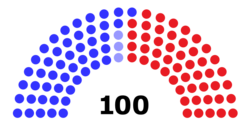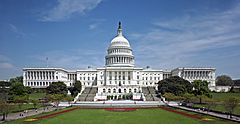United States Congress facts for kids
Quick facts for kids United States Congress |
|
|---|---|
| 118th United States Congress | |
 |
|
| Type | |
| Type | |
| Houses | Senate House of Representatives |
| History | |
| Founded | March 4, 1789 |
| Preceded by | Congress of the Confederation |
|
New session started
|
January 3, 2023 |
| Leadership | |
| Structure | |
| Seats |
|
 |
|
|
Senate political groups
|
Majority (51)
Minority (49)
|
 |
|
|
House of Representatives political groups
|
Majority (220)
Minority (212)
Vacant (3)
|
| Elections | |
|
Senate last election
|
November 8, 2022 |
|
House of Representatives last election
|
November 8, 2022 |
|
Senate next election
|
November 5, 2024 |
|
House of Representatives next election
|
November 5, 2024 |
| Meeting place | |
 |
|
| United States Capitol Washington, D.C. United States of America |
|
| Constitution | |
| United States Constitution, article I | |
The United States Congress is the law-making part of the United States government. It meets in the United States Capitol building in Washington, D.C. Congress is very important because it creates the rules and laws that all Americans follow.
Congress has two main parts, called "houses." This two-house system is known as a bicameral legislature. Bi means "two," and camera means "chamber" or "room."
- The first house is the United States House of Representatives. There are 435 members in the House. The number of representatives each state gets depends on how many people live there. States with more people have more representatives.
- The second house is the United States Senate. There are 100 senators in total. Each state, no matter how big or small, gets two senators.
Contents
How Congress Makes Laws
The main job of Congress is to write, discuss, and pass new laws. These proposed laws are called bills. For a bill to become a law, both the House of Representatives and the Senate must agree on the exact same version of the bill.
Passing a Bill
- First, a bill is introduced in either the House or the Senate.
- It then goes through committees, where members study, discuss, and change it.
- If a committee approves, the bill is voted on by the full House or Senate.
- More than half of the members must vote "yes" for the bill to pass in that house.
- Once one house passes the bill, it goes to the other house for their vote.
- Both houses must pass the identical bill.
The President's Role
After both houses pass a bill, it is sent to the President.
- If the President agrees with the bill, they sign it within 10 days, and it becomes a law.
- If the President does not agree, they can veto (reject) the bill. They send it back to Congress with their reasons.
- If the President does nothing with the bill for 10 days, it usually becomes law anyway. This happens as long as Congress is still meeting. If Congress ends its session during those 10 days, the bill does not become law.
Overriding a Veto
Congress has a way to make a bill a law even if the President vetoes it. This is called an override.
- For an override to happen, more than two-thirds of the members in both the House and the Senate must vote to pass the bill again.
- If they succeed, the bill becomes law, even without the President's signature.
What Laws Can Congress Make?
The United States Constitution is like a rulebook for the government. Article 1 of the Constitution clearly lists the types of laws Congress is allowed to make. This helps make sure Congress stays within its powers.
Rules for Members of Congress
Members of Congress have certain rules and protections while they are working.
- They cannot be arrested for most crimes while Congress is in session, or when they are traveling to or from a session. This helps them do their job without being unfairly stopped.
- Each house of Congress can also decide to remove one of its own members. This is called "expelling" a member. It requires more than two-thirds of the members to vote to remove them.
Political Parties and Bills
In Congress, members belong to different political parties. The party with the most members in a house is called the "majority party." This party usually has a lot of power. They often decide which bills will be discussed and voted on in their house.
Related page
Images for kids
-
George Washington leading the signing of the Constitution of the United States
-
Congress watches over other government branches. Here, the Senate Watergate Committee investigated President Richard Nixon in the 1970s.
-
A view of the United States Capitol building.
-
The Federalist Papers were essays written to explain why a strong connection between citizens and their representatives was important.
See also
 In Spanish: Congreso de los Estados Unidos para niños
In Spanish: Congreso de los Estados Unidos para niños












